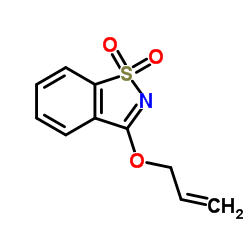Different responses of two genes associated with disease resistance loci in maize (Zea mays L.) to 3-allyloxy-1,2-benzothiazole 1,1-dioxide.
Jiazheng Yuan, Jennifer Tedman, Liakat Ali, Jie Liu, Jeff Taylor, David Lightfoot, Michiaki Iwata, K Peter Pauls
Index: Curr. Issues Mol. Biol. 11 Suppl 1 , i85-94, (2009)
Full Text: HTML
Abstract
Probenazole (3-allyloxy-1,2-benzothiazole 1,1-dioxide, PBZ) is a bactericide and fungicide that acts by inducing plant defense systems. It has been shown to induce the expression of NBS-LRR genes like RPR1 (rice probenazole-response gene) in rice (Oryza sativa L.) and systemic acquired resistance (SAR)-like disease resistance. Two maize (Zea mays L.) genes Zmnbslrr1 (a NBS-LRR gene, cloned from a disease resistance analog PIC11 based) and Zmgc1, (a putative guanylyl cyclase-like gene) have both been associated with quantitative resistance loci (QTL) for resistance to Fusarium graminearum. PIC11 was associated with Fusarium stalk rot and ZmGC1 showed resistance to Gibberella ear rot caused by F. graminearum. The objectives of the current study here were to characterize the Zmnbslrr1 gene and to determine whether it and Zmgc1 respond to the inducer PBZ. The transcript abundance of Zmnbslrr1 expression was significantly reduced in corn seedlings of the Gibberella ear rot resistant genotype CO387 48 h after PBZ treatment. In contrast, the transcript abundance of the maize Zmgc1 gene increased more than 10-fold 8h after the treatment. Therefore, the two genes do not appear to be coordinately regulated by PBZ.
Related Compounds
| Structure | Name/CAS No. | Molecular Formula | Articles |
|---|---|---|---|
 |
3-(Allyloxy)-1,2-benzothiazole 1,1-dioxide
CAS:27605-76-1 |
C10H9NO3S |
|
Characterization of PBZ1, a probenazole-inducible gene, in s...
2001-01-01 [Biosci. Biotechnol. Biochem. 65(1) , 205-8, (2001)] |
|
Proteome analysis of probenazole-effect in rice-bacterial bl...
2009-01-01 [Protein Pept. Lett. 16(9) , 1041-52, (2009)] |
|
Occupational contact dermatitis caused by probenazole in agr...
2009-12-01 [Contact Dermatitis 61(6) , 350-1, (2009)] |
|
Semisynthesis and antifeedant activity of new derivatives of...
2013-01-01 [Int. J. Mol. Sci. 14 , 19484-93, (2013)] |
|
A novel rice PR10 protein, RSOsPR10, specifically induced in...
2004-05-01 [Plant Cell Physiol. 45(5) , 550-9, (2004)] |